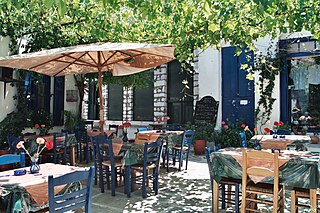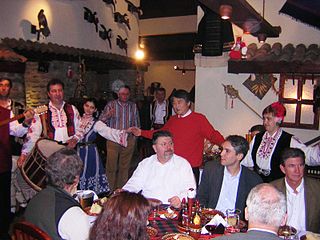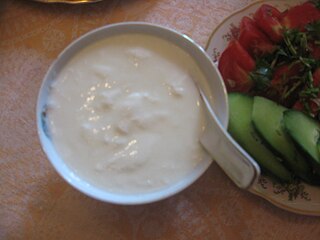
Greek cuisine is a Mediterranean cuisine. Contemporary Greek cookery makes wide use of vegetables, olive oil, grains, fish, wine, and meat. Other important ingredients include olives, pasta, cheese, lemon juice, herbs, bread and yoghurt. The most commonly used grain is wheat; barley is also used. Common dessert ingredients include nuts, honey, fruits, and filo pastries. It is strongly influenced by Ottoman cuisine and thus, especially cuisine of anatolian Greeks shares foods such as baklava, tzatziki, gyro, moussaka, dolmades, yuvarlakia and keftethes with the neighboring countries. To an even greater extent it is influenced by Italian cuisine and cuisines from other neighboring south European countries, and thus, especially in southern regions and the islands it includes several kinds of pasta, like hyllopites, gogkes and tziolia.

Turkish cuisine is largely the heritage of Ottoman cuisine, which can be described as a fusion and refinement of Central Asian, Middle Eastern, Eastern European and Balkan cuisines. Turkish cuisine has in turn influenced those and other neighbouring cuisines, including those of Southeast Europe (Balkans), Central Europe, and Western Europe. The Ottomans fused various culinary traditions of their realm with influences from Levantine cuisines, along with traditional Turkic elements from Central Asia, creating a vast array of specialities—many with strong regional associations.

Tzatziki, cacık or tarator is a dip, soup, or sauce found in the cuisines of Southeast Europe and the Middle East. It is made of salted strained yogurt or diluted yogurt mixed with cucumbers, garlic, salt, olive oil, sometimes with vinegar or lemon juice, and herbs such as dill, mint, parsley and thyme. It is generally served as a cold appetizer (meze) or a side dish.

Yogurt, yoghurt or yoghourt is a food produced by bacterial fermentation of milk. The bacteria used to make yogurt are known as yogurt cultures. The fermentation of lactose by these bacteria produces lactic acid, which acts on milk protein to give yogurt its texture and characteristic tart flavor. Cow's milk is commonly available worldwide and, as such, is the milk most commonly used to make yogurt. Milk from water buffalo, goats, ewes, mares, camels, and yaks is also used to produce yogurt where available locally. The milk used may be homogenized or not, even pasteurized or raw. Each type of milk produces substantially different results.

Raita is the common name of a condiment, originating from the Indian subcontinent, made with dahi together with raw or cooked vegetables, more seldom fruit, or in the case of boondi raita, with fried droplets of batter made from besan.

A meyhane is a traditional restaurant or bar in Turkey, Azerbaijan, Iran and the Balkans. It serves alcoholic beverages like wine, rakı, vodka, beer with meze and traditional foods. "Meyhane" means house of wine and is composed of two Persian words: mey (wine) and khāneh (house). The word entered the Serbian and Bulgarian languages as mehana and in Macedonian as meana. In Bosnian language the word "mejhana" is used. A meyhane used to serve mainly wine alongside meze until the late 19th century when rakia established itself as the quasi-official national drink of Bulgaria. In Serbia, the word mehana is considered archaic, while in Bulgaria it refers to a restaurant with traditional food, decoration and music.

Bulgarian cuisine is a representative of the cuisine of Eastern Europe. It shares characteristics with other Balkan cuisines. Bulgarian cooking traditions are diverse because of geographical factors such as climatic conditions suitable for a variety of vegetables, herbs and fruit. Aside from the vast variety of local Bulgarian dishes, Bulgarian cuisine shares a number of dishes with Persian, Turkish, and Greek cuisine.
Serbian cuisine is the traditional cuisine of Serbia, sharing characteristics with the rest of the Balkan nations.

Iraqi cuisine or Mesopotamian cuisine has a long history going back some 10,000 years – to the Sumerians, Akkadians, Babylonians, Assyrians, and ancient Persians. Tablets found in ancient ruins in Iraq show recipes prepared in the temples during religious festivals – the first cookbooks in the world. Ancient Iraq, or Mesopotamia, was home to a sophisticated and highly advanced civilization, in all fields of knowledge, including the culinary arts. However, it was in the Islamic Golden Age when Baghdad was the capital of the Abbasid Caliphate (750–1258) that the Iraqi kitchen reached its zenith. Today, the cuisine of Iraq reflects this rich inheritance as well as strong influences from the culinary traditions of neighbouring Iran, Turkey and the Syria region area.

Cypriot cuisine is the cuisine of Cyprus and is closely related to Greek and Turkish cuisine; it has also been influenced by Byzantine, French, Italian, Catalan, Ottoman and Middle Eastern cuisines.

Levantine cuisine is the traditional cuisine of the Levant, known in Arabic as the Bilad al-Sham and Mashriq, which covers a large area of the Eastern Mediterranean. It continues to carry an influentially mainstream character in a majority of the dishes today. It is found in the modern states of Jordan, Lebanon, Israel, Palestine, Syria, and parts of southern Turkey near Adana, Gaziantep, and Antakya. In the broader family of Mediterranean cuisine, Cypriot cuisine also has strong Levantine influences. Conversely, some of the dishes listed below may have early origins in neighboring regions, but have long since become traditions in the Levant.

Aush, sometimes spelled ash, aash, or āsh, is a thick soup/stew, which is usually served hot and is part of Afghan, Iranian, Azerbaijani, Caucasian, and Turkish cuisine. The spelling of the name of this dish varies in English and can include āsh, aush, ashe, ashe, āshe or aash.

Strained yogurt, Greek yogurt, yogurt cheese, or sack yoghurt is yogurt that has been strained to remove most of its whey, resulting in a thicker consistency than unstrained yogurt, while preserving yogurt's distinctive sour taste. Like many types of yogurt, strained yogurt is often made from milk that has been enriched by boiling off some of its water content, or by adding extra butterfat and powdered milk. In Europe and North America, it is often made from low-fat or fat-free milk. In Iceland, a similar product named skyr is made.
The term leben, variously laban, lben is used across the Arab World, to refer to a food or beverage of fermented milk. Generally, there are two main products known as leben: in the Levant region, yogurt; and in Arabia and North Africa (Maghreb), buttermilk. The practice of intentionally allowing milk to sour has been known since ancient times and practiced by many cultures.

Greek-American cuisine is the cuisine of Greek Americans and their descendants, who have modified Greek cuisine under the influence of American culture and immigration patterns of Greeks to the United States. As immigrants from various Greek areas settled in different regions of the United States and became "Greek Americans," they carried with them different traditions of foods and recipes that were particularly identified with their regional origins in Greece and yet infused with the characteristics of their new home locale in America. Many of these foods and recipes developed into new favorites for town peoples and then later for Americans nationwide. Greek-American cuisine is especially prominent in areas of concentrated Greek communities, such as Astoria, Queens and Tarpon Springs, Florida.

The Sofra is a restaurant chain in London, United Kingdom, which serves Turkish cuisine. The chef patron is Hüseyin Özer. It was established in 1981 as a small restaurant, which turned later into a chain of restaurants, currently in Mayfair and St Christopher's Place, off Oxford Street. Sofra restaurants are regarded the best Turkish cuisine restaurants outside Turkey, ranking first in a list published by the newspaper Hürriyet.

















